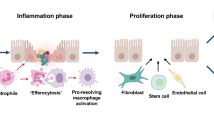Abstract.
Following injury a complex but well-orchestrated cellular response stimulating wound healing and tissue regeneration is induced. The balance of different cytokines, growth factors and cells is important in regulating tissue reorganisation. The immune system is critically involved in this process. Toll-like receptors (TLRs) are essential to the innate immune system, recognising microbial pathogens. The recent identification of endogenous ligands of TLRs suggests that they function not only to induce defensive antimicrobial immune responses but also as a sensitive detection system to initiate tissue regeneration after injury. Here we present an overview of TLRs and their endogenous ligands, and also review the roles of TLRs in inducing tissue regeneration after injury and in maintaining homeostasis. The identification of endogenous TLR ligands and their involvement in inducing tissue regeneration will provide new options to improve tissue reorganization after injury.
Similar content being viewed by others
Author information
Authors and Affiliations
Corresponding author
Additional information
Received 26 April 2006; received after revision 16 June 2006; accepted 24 August 2006
Rights and permissions
About this article
Cite this article
Zhang, Z., Schluesener, H.J. Mammalian toll-like receptors: from endogenous ligands to tissue regeneration. Cell. Mol. Life Sci. 63, 2901–2907 (2006). https://doi.org/10.1007/s00018-006-6189-1
Published:
Issue Date:
DOI: https://doi.org/10.1007/s00018-006-6189-1




